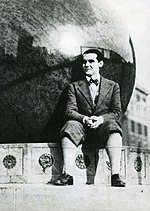Alma Mater (New York sculpture)
1903 sculpturesAllegorical sculptures in New York CityBooks in artBronze sculptures in ManhattanColumbia University campus ... and 8 more
Monuments and memorials in ManhattanOutdoor sculptures in ManhattanSculptures by Daniel Chester FrenchSculptures of birds in the United StatesSculptures of women in New York CityStatues in New York CityUse mdy dates from September 2021Vandalized works of art in New York City

Alma Mater is a bronze sculpture by Daniel Chester French which is located on the steps of the Low Memorial Library on the campus of Columbia University, in the Morningside Heights neighborhood of Manhattan, New York City. French designed the statue in 1901, and it was installed in September 1903. It is a personification of the alma mater, which represents Columbia in its role as an educational institution; since its installation, the statue has become closely associated with the image of the university.
Excerpt from the Wikipedia article Alma Mater (New York sculpture) (License: CC BY-SA 3.0, Authors, Images).Alma Mater (New York sculpture)
Low Plaza, New York Manhattan
Geographical coordinates (GPS) Address Nearby Places Show on map
Geographical coordinates (GPS)
| Latitude | Longitude |
|---|---|
| N 40.807833333333 ° | E -73.962138888889 ° |
Address
Low Plaza
Low Plaza
New York, Manhattan
New York, United States
Open on Google Maps






